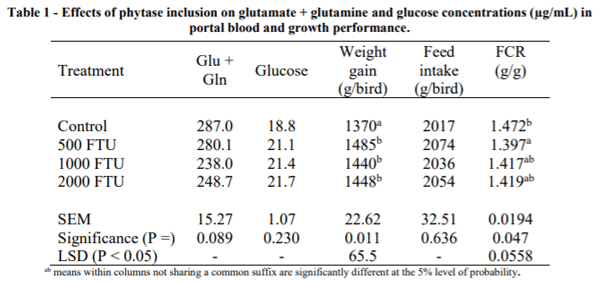I. INTRODUCTION
Exogenous phytase improved ileal amino acid digestibility by an average of 5% based on 745 observations across 24 studies in a systematic review (Cowieson et al., 2017). Nevertheless, the post-enteral availability of amino acids is ultimately determined by their transition across enterocytes in the gut mucosa. Amino acids may be denied access to the portal circulation because they may enter numerous anabolic pathways, or they may be catabolized for energy provision. Thus, the catabolism of amino acids within the gut mucosa is of importance and glutamate/glutamine and glucose are the primary energy substrates (Watford et al., 1979). It follows that the ‘catabolic ratio’ of glutamate plus glutamine to glucose within enterocytes may be manipulated by dietary strategies to derive energy more efficiently. Previously, 500 FTU/kg phytase increased the average digestibility coefficient of 16 amino acids by 49.7% (0.720 versus 0.481) in the proximal jejunum, 20.1% (0.801 versus 0.667) in the distal jejunum, 9.07% (0.878 versus 0.805) in the proximal ileum and 7.24% (0.904 versus 0.843) in the distal ileum (Truong et al., 2015). The authors concluded that phytase generates a ‘proximal shift’ in sites of amino acid absorption which may spare amino acids from catabolism in the gut mucosa.
To determine the extent of amino acid catabolism within the gut mucosa, net amino acid concentrations within portal blood were measured previously in pigs (Stoll et al., 1998). Therefore, the present study determined the influence of exogenous phytase inclusion in poultry diets on gross concentrations of amino acids and glucose within the portal circulation.
II. MATERIALS AND METHODS
Wheat-soybean meal based broiler diets were formulated to standard specifications and supplemented with 0, 500, 1000 and 2000 FTU/kg phytase (Buttiauxella sp. expressed in Trichoderma reesei; Axtra® PHY, Danisco Animal Nutrition, Marlborough, UK) added over the top. Diets were offered to eight replicate cages (6 birds/cage) or a total of 192 male Ross 308 chicks from 7 to 28 days post-hatch. The accuracy of the phytase inclusions was confirmed by analysis using the standard method of Engelen et al. (1994). Blood samples were taken from the anterior mesenteric vein from three birds per cage following euthanasia at 28 days posthatch. Blood samples were centrifuged and the decanted plasma stored at −80°C prior to analysis. Concentrations of 16 proteinogenic amino acids in plasma were determined using methods described in Selle et al. (2016). Growth performance, nutrient utilisation and amino acid digestibility were also determined as described in Moss et al. (2018) (data not shown). Data were analysed using IBM® SPSS® Statistics (IBM Corporation. Somers, NY). A probability level of less than 5% was considered statistically significant. The study complied with guidelines approved by the Animal Ethics Committee of The University of Sydney.
III. RESULTS
Overall, birds outperformed 2014 Ross 308 objectives (values given in parentheses) with a mean weight gain of 1436 g/bird (1387 g/bird), feed intake of 2045 g/bird (2052 g/bird) and an FCR of 1.426 (1.479) from 7 to 28 days post-hatch. The effects of phytase inclusions on glutamic acid plus glutamine and glucose concentrations (µg/mL) in portal plasma and growth performance are shown in Table 1. Phytase inclusion significantly improved weight gain and FCR but did not influence feed intake. Phytase inclusion did not influence glutamic acid and glutamine concentrations via a one-way ANOVA; however, phytase linearly reduced concentrations of glutamic acid plus glutamine in the portal circulation (r = -0.363; P < 0.05). Similarly, phytase did not influence glucose concentrations via an ANOVA; however, there was a significant logarithmic relationship where phytase increased plasma glucose concentrations in portal blood (R2 = 0.127; P < 0.05). The effects of 500 FTU phytase on essential and non-essential amino acid concentrations (µg/mL) in portal plasma are shown in Table 2 where phytase inclusion increased the concentration of seven amino acids.


IV. DISCUSSION
Phytase inclusion of 500 FTU/kg generated the largest weight gain and most efficient feed conversion in comparison with the control. Therefore, it is relevant that at the standard 500 FTU/kg inclusion, phytase significantly increased concentrations of free amino acids in portal blood; including isoleucine (17.8%), leucine (18.0%), lysine (39.6%), phenylalanine (13.8%), tryptophan (28.1%), valine (13.2%) and serine (18.0%). Glucose and amino acids (particularly glutamate/glutamine) are critical energy sources for the intestinal mucosa as they may be catabolised to provide energy in avian enterocytes (Watford et al., 1979). Whether these energy sources are open to nutritional manipulation is unknown (Reeds et al., 2000). In the present study, phytase inclusion linearly reduced concentrations of glutamic acid and glutamine in the portal circulation (r = -0.363; P = 0.049) and increased plasma glucose levels by a logarithmic relationship (R2 = 0.127; P = 0.045) in portal plasma. Thus, it appears that the energy source utilised by the intestinal mucosa may be subject to manipulation by phytase inclusion. Phytase may be sparing glucose and perhaps other amino acids from catabolism and increasing their entry into the portal vein by favoring glutamate/glutamine for catabolism. These relationships alone do not prove causation and more research is required. However, it is instructive that the ratio of glutamate plus glutamine to glucose concentrations within portal blood is significantly related phytase inclusion (R2 = 0.252; P < 0.05) and FCR (R2 = 0.374; P < 0.005), where the more efficient FCR was generated in birds with relatively more glucose present within portal plasma (Figure 1). The likelihood is that manipulation of the energy source of the gut mucosa with phytase inclusion has contributed to improvements in feed efficiency in the present study. Therefore, it appears that phytase can influence the metabolic fates of amino acids and glucose in the gut mucosa. Phytase may be sparing glucose and other amino acids from catabolism as reflected in the reduced entry of glutamic acid/glutamate into the portal circulation. Clearly, additional studies are required to confirm this important observation.

ACKNOWLEDGEMENTS: The authors would like to acknowledge and thank Feedworks Pty Ltd, Australian Proteome Analytical Facility at Macquarie University and Bioplatforms for funding this study.
Abstract presented at the 30th Annual Australian Poultry Science Symposium 2019. For information on the latest edition and future events, check out https://www.apss2021.com.au/. 














.jpg&w=3840&q=75)